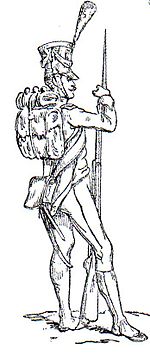Tirailleurs

Tirailleurs ( French: riflemen ) are teams of the infantry fighting in a dissolved order , also called skirmishers . They belong to the light infantry . France was the first country to set up Tirailleur units during the French Revolution , and later also in its colonies ( Tirailleurs algériens , Tirailleurs sénégalais ). In mainland France, the voltigeurs performed the same task between 1804 and 1868/70 .
Before the development of modern tirailleur tactics, soldiers armed with arquebuses had generally fought outside the strictly ordered battle formation since the 15th century in order to have more space to aim. At the same time, their ability to move in the terrain was not as severely restricted as that of the violence heap. With the advancement of weapons technology and the invention of the bayonet , which replaced the pike of the pikemen , this tactic was largely replaced in Europe by the closed formation at the beginning of the 17th century . Only the few troops armed with rifled rifles , such as the hunters , the free battalions, and poorly trained militias and irregulars , maintained the scattered battle.
Towards the end of the 18th century, rifle units were reintroduced in addition to line tactics . The tirailleurs first achieved great importance during the French Revolution as part of the new French column tactics . At first they were only organized in their own regiments or battalions (of the light infantry), but soon all battalions were assigned such shooters. This was done either through their own companies (e.g. voltigeurs) or - especially in German-speaking countries - in the form of the third (rearmost) members of each department. The tirailleurs became an integral part of the tactics of the 19th century. With the increasing impact of firearms in the course of that century, so did the importance of the tirailleurs.
At the time of Napoleon I , the voltigeurs took over the task of tirailleurs in the French line regiments. The latter were only preserved in the Imperial Guard , where independent Tirailleur regiments formed part of the Young Guard from 1809 . The so-called Tirailleur-Jäger were renamed Voltigeure in 1811, the Tirailleur-Grenadiers have since been called simply Tirailleur.
The tirailleurs swarmed out in front of their battalions (sometimes in between) before the fight. Usually some of them were left in a closed formation about halfway to serve as reserve and support ("Soutien"). The shooters themselves should work together in groups of two (Rotten), but also as a platoon. This tactic proved to be advantageous against artillery , as tirailleurs could only be hit with difficulty at a great distance. However, they were vulnerable to cavalry attacks . In such a case they should withdraw to their own lines or, if this was no longer possible, form groups as large as possible in order to be able to offer resistance more effectively.
The main task of the tirailleurs was to fight officers of the opposing troops with aimed shots . For this reason, the Tirailleurs were the only troops that were equipped with rifles with rifled barrel, as these, in contrast to the standard weapons of the line troops, guaranteed higher accuracy. This task also marked a change in morality: in the 18th century, the officer corps consisted only of nobles with a few exceptions . Therefore, there was a great sense of cohesion between the officer corps of the different armies. The introduction of the screeching tactic meant a noticeable threat to this noble privilege.
literature
- Tirailleurs Algériens et Tunisiens 1830/1964 , Carnets de la Sabretache, numéro spécial, 1980, série 55
- Anthony Clayton, Histoire de l'Armée française en Afrique 1830-1962 , Albin Michel, 1994
- Robert Huré, L'Armée d'Afrique: 1830-1962 , Charles-Lavauzelle, 1977
- Dominique Lormier, C'est nous les Africains , Calmann-Levy, 2006
- Les Africains , Historama, hors-série numéro 10, 1970
- Razik Alex Menidjel, Les tirailleurs algériens , Éditions Publibook, 2007 ISBN 2748336321
- Eugène-Jean Duval, L'épopée des tirailleurs sénégalais , L'Harmattan, 2005